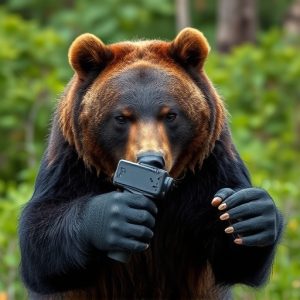Bear Spray Safety: Prevent Accidental Discharges for Human Protection
Bears' acute sense of smell makes them prone to approaching humans in areas with food or garbag…….
Bears' acute sense of smell makes them prone to approaching humans in areas with food or garbage attractants, highlighting the importance of understanding bear behavior and scent control. Bear spray is a vital tool for deterring bears and ensuring safety during outdoor activities. Accidental discharges can be prevented by learning trigger mechanisms, proper storage, and awareness of environmental factors like wind. Choosing the right bear spray based on region and environment, along with responsible usage techniques, minimizes risks for both humans and wildlife. In case of accidental discharge, staying calm, backaway slowly, and avoid running to prevent escalating bear interactions.
“In areas where bears roam, understanding their behavior and implementing effective safety measures is paramount. This article explores an essential tool in bear attack prevention: outdoor bear spray. We delve into the science behind bear sensitivity to scent and how bear spray plays a crucial role in wildlife management and human safety. By examining factors affecting accidental discharges and offering guidance on choosing the right spray for diverse environments, we aim to equip readers with knowledge to navigate bear country confidently, minimizing risks of unwanted encounters and misdischarges.”
- Understanding Bear Behavior and Their Sensitivity to Scent
- The Role of Bear Spray in Wildlife Management and Human Safety
- Factors Affecting Accidental Discharge of Bear Spray
- Choosing the Right Bear Spray for Different Environments
- Effective Techniques for Handling a Bear Spray Misdischarge
Understanding Bear Behavior and Their Sensitivity to Scent
Bears, especially black bears, have a keen sense of smell, making them highly sensitive to certain scents. Understanding their behavior is crucial when it comes to preventing accidental bear spray discharges. Bears are primarily attracted to strong, distinct odors, which can lead them to associate humans with potential food sources. Their natural curiosity and foraging instincts often put them in close proximity to campers and hikers, especially if the area has a high concentration of attractants like food or garbage.
To avoid triggering a bear’s defensive response, it’s essential to be mindful of scent control. Bear spray, when used correctly, can deter bears by targeting their eyes and respiratory system. However, accidental discharges due to improper handling or storage are not uncommon. Preventing such incidents involves learning about the trigger mechanisms of bear spray devices, keeping them out of reach, and ensuring proper ventilation during storage. By minimizing strong scents in bear country, hikers and campers can reduce the risk of unexpected bear encounters and subsequent defensive reactions.
The Role of Bear Spray in Wildlife Management and Human Safety
Bear spray, also known as bear repellent, plays a pivotal role in wildlife management and ensuring human safety in areas inhabited by bears. It is designed to deter bears from approaching humans or their camps, especially during outdoor activities like hiking, camping, or hunting. The primary function of this spray is to create a barrier between humans and bears, providing valuable time for individuals to retreat or seek shelter.
One of the key benefits of bear spray is its ability to prevent accidental discharges, ensuring that users can rely on it when needed most. Effective bear spray formulations are designed with non-irritating components, minimizing harm to both wildlife and people while maximizing deterrence. By using these sprays responsibly, outdoor enthusiasts can significantly reduce the risk of dangerous bear encounters, fostering a safer environment for all.
Factors Affecting Accidental Discharge of Bear Spray
The accidental discharge of bear spray is a concern for both experienced outdoorsmen and novice adventurers alike. Several factors can contribute to unintentional activations, with understanding these being key to preventing incidents. One primary factor is user error, where improper handling or lack of training can lead to accidental triggers. Bear spray cans are designed with safety mechanisms, but these can be overcome if the user does not follow proper procedures, such as keeping the canister upright and avoiding extreme temperatures that may cause the spray to activate unexpectedly.
Another significant aspect is environmental conditions. Wind plays a crucial role; even a light breeze can carry bear spray in unexpected directions, potentially leading to off-target releases. Additionally, terrain and vegetation can impact the range and dispersion of the spray, with uneven ground or dense brush potentially causing the user to misjudge the effective range. Awareness of these factors is vital for responsible use, ensuring that bear spray remains a reliable deterrent when needed while minimizing the risk of accidental discharge.
Choosing the Right Bear Spray for Different Environments
When selecting a bear spray for outdoor adventures, considering the environment is key to ensuring its effectiveness. Different regions present varying bear species and behaviors, so choosing the right spray means understanding these nuances. For instance, lighter sprays with higher concentrations of capsaicin are ideal for dense forests where proximity to bears might be more likely. These areas often involve encounters with black bears known for their aggression in defended territories.
In contrast, for open alpine regions inhabited by grizzly bears, a heavier-duty spray with a stronger blast pattern and higher pressure is recommended. Accidental bear spray discharge prevention techniques should also be practiced, such as keeping the nozzle away from your body and aiming at the bear’s face if needed. This ensures responsible usage and minimizes the risk of unintentional harm or environmental impact.
Effective Techniques for Handling a Bear Spray Misdischarge
In the event of an accidental bear spray discharge, staying calm and knowing how to handle the situation is crucial for ensuring your safety and minimizing potential harm to bears. If a spray misfires or releases prematurely, quickly assess your surroundings. Move away slowly and at an angle from the area where the spray cloud is concentrated, avoiding direct contact with any bear spray particles. Do not run, as this can trigger a chase response in bears. Instead, back away while remaining aware of the bear’s location and behavior.
To prevent accidental discharges, always follow safety guidelines when carrying and using bear spray. Store it properly in its original container, keep it out of reach of children and untrained individuals, and ensure the nozzle is facing away from you when not in use. Familiarize yourself with the product’s activation mechanism, and practice targeting techniques to avoid misting unwanted areas. Regularly inspect your spray for damage or expiration, replacing it as needed to maintain its effectiveness.
Understanding bear behavior and their sensitivity to scent is key to preventing outdoor accidents. Bear spray has proven to be an effective tool in wildlife management and human safety, but proper usage and choosing the right type for your environment are crucial. By being aware of factors that can lead to accidental discharges and employing techniques to handle misdischarges, you can enhance your safety in bear country. Remember, prevention and preparation are vital when navigating areas with bears, so always carry bear spray and know how to use it effectively.


